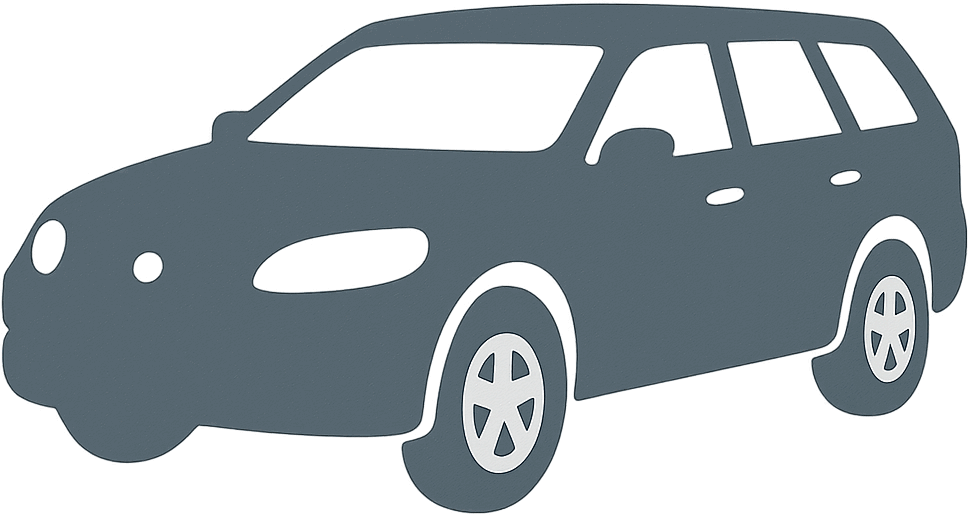 1971 Lada 2102 Dimensions, Size & Specs
1971 Lada 2102 Dimensions, Size & Specs
Measurements of the 1971 Lada 2102, engineered for optimal performance and comfort
| Dimensions | |
|---|---|
| Length: | 4059 mm159.8 in13.3 ft |
| Width: | 1611 mm63.4 in5.3 ft |
| Height: | 1458 mm57.4 in4.8 ft |
| Trunk Capacity: | 345 liter12.2 cu ft |
| Trunk Capacity (Max): | 1345 liter47.5 cu ft |
| Weight Specifications | |
| Curb Weight: | 1010 kg2227 lbs |
| Tire Specifications | |
| Tire Size: |
|
The Lada 2102 is a classic Soviet-era station wagon produced from 1971 to 1984, known for its practicality and robust design. With a length of 4059 mm (approximately 159.7 inches), a width of 1611 mm (about 63.4 inches), and a height of 1458 mm (approximately 57.4 inches), the 2102 offers a compact yet spacious profile suitable for various uses. Weighing in at a curb weight of 1010 kg (2227 lbs), it balances lightweight construction with enough mass for road stability. The station wagon design enhances utility, featuring a luggage capacity of 345 liters (12.2 cubic feet) under normal conditions and expanding to a substantial 1345 liters (47.5 cubic feet) when the rear seats are folded down, making it ideal for transporting larger loads or gear. The vehicle rides on 155/80 SR13 tires, contributing to a comfortable and reliable driving experience typical of vehicles of its era. Overall, the Lada 2102 remains a notable choice among vintage station wagons, appreciated for its functional size and enduring reliability in the context of early 1970s automotive engineering.
Discover the standout features that make the 1971 Lada 2102 a leader in its class
Have a question? Please check our knowledgebase first.
The Lada 2102 station wagon has a length of 4059 mm (approximately 159.7 inches), a width of 1611 mm (about 63.4 inches), and a height of 1458 mm (around 57.4 inches). These compact dimensions made the 2102 suitable for urban and suburban driving during its production from 1971 to 1984, providing a practical yet compact footprint for a station wagon class vehicle.
Yes, the Lada 2102 typically fits comfortably into a standard residential garage. Standard garages commonly accommodate vehicles up to around 6 meters (19.7 feet) in length and 2.4 meters (7.9 feet) in width. Since the 2102 measures 4059 mm (around 4.06 meters or 13.3 feet) long and 1611 mm (approximately 1.61 meters or 5.3 feet) wide, it leaves ample space for easy parking and opening doors inside a typical garage.
The Lada 2102 offers a luggage capacity of 345 liters (approximately 12.18 cubic feet) with the rear seats in their upright position. When the rear seats are folded down, the luggage space expands significantly to 1345 liters (approximately 47.5 cubic feet). This flexibility makes the 2102 very practical for carrying larger items while retaining the option to seat rear passengers when needed.
The Lada 2102 has a curb weight of 1010 kg (roughly 2227 pounds). This relatively light weight for a station wagon aids in its maneuverability and fuel economy, especially considering its production era between 1971 and 1984. The lighter curb weight contributes to easier handling and modest fuel consumption, factors that appeal to drivers needing an efficient and practical vehicle for everyday use.
The Lada 2102 is equipped with 155/80 SR13 tires. These tires measure 155 mm in width, with an aspect ratio of 80% height to width, and fit 13-inch diameter wheels. This tire setup balances ride comfort with decent handling characteristics for its class and period, offering sufficient cushioning on uneven roads while maintaining reasonable grip and stability.
Compared to modern compact station wagons, the Lada 2102 is smaller in almost every dimension. Its length of 4059 mm (approximately 13.3 feet) and width of 1611 mm (about 5.3 feet) place it well within the small car category by today’s standards, whereas many modern compact wagons tend to be larger, often exceeding 4.5 meters (15 feet) in length and around 1.8 meters (6 feet) in width. The 2102’s smaller size reflects automotive design priorities of its time, favoring simplicity and utility.
Dimensionally, the Lada 2102 is very similar to its predecessor, the Lada 2101, since it is essentially a station wagon variant based on the 2101 sedan. Both models share a similar platform and many components; however, the 2102’s body style includes an extended rear section to accommodate the station wagon configuration. Despite this, the overall length and width remain quite close, with the 2102 measuring 4059 mm long compared to the 2101’s slightly shorter length. The design changes primarily affect cargo volume and roof height at the rear.
The Lada 2102 is classified as a station wagon, a body style designed for versatility and cargo space. It was produced primarily for customers needing more luggage or equipment space than a standard sedan offered. The station wagon configuration allows for larger cargo capacity with rear seats that fold down, making it suitable for family use, small businesses, and utility purposes, especially in the Soviet and Eastern European markets during its production years from 1971 to 1984.
When compared to similar station wagons produced in the 1970s and early 1980s, such as the Volkswagen Variant or the Ford Escort Wagon, the Lada 2102 holds its own in terms of simplicity and utility. While slightly smaller in some dimensions and lighter, the 2102 offered robust mechanics that were easier to maintain in harsher conditions. Its overall size is compact but functional, with adequate cargo capacity, making it a practical choice within its market niche. However, in terms of interior refinement and performance, Western wagons often featured more advanced features.
While specific interior dimensions for the Lada 2102 are not commonly listed, the 2102 is based on the Lada 2101 platform with a focus on practical passenger accommodation. With a height of 1458 mm (around 57.4 inches) and a functional station wagon roofline, the 2102 provides reasonable headroom and legroom for front and rear passengers typical of compact cars of its era. The rear folding seats add flexibility for passenger or cargo needs, making the interior a versatile space for families or utility tasks.
Discover similar sized cars.

| Production: | 1999-2000 |
|---|---|
| Model Year: | 1999 |
| Length: | 4026 mm158.5 in |
| Width: | 1610 mm63.4 in |
| Height: | 1470 mm57.9 in |

| Production: | 1971-1986 |
|---|---|
| Model Year: | 1971 |
| Length: | 4059 mm159.8 in |
| Width: | 1611 mm63.4 in |
| Height: | 1458 mm57.4 in |

| Production: | 1971-1985 |
|---|---|
| Model Year: | 1971 |
| Length: | 4059 mm159.8 in |
| Width: | 1611 mm63.4 in |
| Height: | 1458 mm57.4 in |

| Production: | 1997-2002 |
|---|---|
| Model Year: | 1997 |
| Length: | 4025-4056 mm158.5-159.7 in |
| Width: | 1610 mm63.4 in |
| Height: | 1390-1470 mm54.7-57.9 in |
